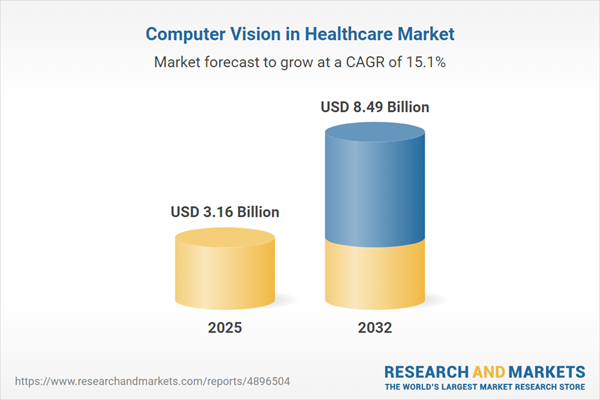Speak directly to the analyst to clarify any post sales queries you may have.
Computer vision is redefining how healthcare organizations manage clinical operations, drive operational efficiency, and achieve high standards of care. Senior decision-makers are increasingly prioritizing this technology to address regulatory, workflow, and quality challenges in a rapidly changing environment.
Market Snapshot: Computer Vision in Healthcare
The computer vision in healthcare market reached USD 2.76 billion in 2024, fueled by a 15.05% compound annual growth rate (CAGR). Adoption is advancing across hospitals, diagnostics centers, and research environments, where organizations are leveraging this technology to enhance imaging, streamline administrative processes, and improve clinical outcomes. As care models grow more complex and regulations evolve, digital agility becomes essential for effective adaptation. Automation using computer vision leads to reduced manual tasks, greater workflow precision, and helps organizations meet both patient needs and compliance expectations. Platforms focused on image analysis, advanced diagnostics, and real-time data are critical to building robust healthcare systems capable of responding to emerging demands.
Scope & Segmentation
- Hardware Solutions: Integrate advanced imaging devices, specialized sensors, and high-performance computing to collect clinical data efficiently, whether at point-of-care locations or within major diagnostic facilities.
- Software Capabilities: Deploy AI-powered tools for fast, precise image interpretation and timely clinical decision-making across all points of the patient journey.
- Services: Ensure seamless adoption with integration support and ongoing maintenance, maintaining uninterrupted operations even in complex health system deployments.
- Technological Innovations: Harness artificial intelligence, machine learning, and analytics to strengthen clinical support, automate workflows, and enhance care delivery across departments.
- Deployment Models: Choose between cloud-based and on-premise solutions to address compliance, security, scalability, and infrastructure needs unique to each organization and region.
- Applications: Apply computer vision for diagnostic imaging, surgical navigation, patient monitoring, research, and drug development, promoting consistency and accuracy in care.
- End User Segments: Utilize solutions in hospitals, clinics, labs, and diagnostic centers to optimize resource utilization, streamline internal workflows, and uphold consistent standards of care.
- Regional Dynamics: Recognize that North America and Europe focus on digital transformation, Asia-Pacific invests in scalable solutions, and the Middle East and Africa address distinct regulatory and technical hurdles in adoption.
- Leading Solution Providers: Consider offerings from organizations like NVIDIA Corporation, Microsoft Corporation, viso.ai AG, Tempus AI Inc., oxipit.ai, and Medtronic Inc., all of which provide adaptable computer vision solutions for diverse environments.
Key Takeaways for Decision-Makers
- Integrating artificial intelligence in healthcare operations allows for improved collaboration across disciplines, smoother documentation processes, and more effective information exchange system-wide.
- Flexible IT infrastructures are essential for rapid response to regulatory changes, ensuring organizations maintain compliance and operational resilience as requirements shift.
- Partnering with technology vendors streamlines platform implementation, aligning solutions to both immediate and future organizational needs.
- Combining computer vision solutions with electronic health records and telehealth platforms facilitates scalable, adaptable care models that support evolving organizational strategies.
- Leveraging advanced imaging and analytics capabilities boosts diagnostic precision, drives productivity improvements, and fosters innovation in research-driven healthcare settings.
- Customizing deployments to regional compliance standards and market needs ensures secure, scalable expansion and reliable performance in new markets.
Tariff Impact on Procurement and Deployment
Recent changes in U.S. tariffs have led to increased costs for hardware acquisition in computer vision healthcare solutions. Procurement teams are responding by updating sourcing strategies, prioritizing alternative suppliers, and selecting modular equipment that supports flexible deployment and adjustments. These approaches reinforce organizational agility and resilience during regulatory and economic fluctuations.
Methodology & Data Sources
This report draws on a blended approach, incorporating executive interviews, expert insights, regulatory analyses, and peer-reviewed publications. This combination ensures a comprehensive understanding of computer vision adoption trends and their organizational impact.
Why This Report Matters
- Provides senior executives with practical benchmarks and actionable frameworks for steering digital transformation and driving measurable operational improvements.
- Enables procurement and operations leaders to proactively navigate supply chain and compliance challenges with targeted, up-to-date market intelligence.
- Empowers leadership teams to choose technology partners aligned to evolving business objectives and strategic growth, supporting both local and cross-border initiatives.
Conclusion
Computer vision supports healthcare leaders in driving ongoing operational improvement, sustaining care quality, and supporting long-term organizational advancement. The insights provided help build resilient, future-ready systems that meet the sector’s changing demands.
Additional Product Information:
- Purchase of this report includes 1 year online access with quarterly updates.
- This report can be updated on request. Please contact our Customer Experience team using the Ask a Question widget on our website.
Table of Contents
3. Executive Summary
4. Market Overview
7. Cumulative Impact of Artificial Intelligence 2025
Companies Mentioned
The companies profiled in this Computer Vision in Healthcare market report include:- NVIDIA Corporation
- Microsoft Corporation
- viso.ai AG
- Tempus AI, Inc.
- oxipit.ai
- Medtronic Inc.
- Keyence Corporation
- Iterative Health, Inc.
- Intelligent Ultrasound Group
- Intel Corporation
- Innovacio Technologies
- InData Labs Group Ltd.
- iCAD Inc.
- Google LLC by Alphabet Inc.
- GE HealthCare Technologies Inc.
- Fujitsu Limited
- Enlitic, Inc.
- Descartes Labs Inc.
- Caregility Corporation
- Butterfly Network, Inc.
- Basler AG
- Alteryx, Inc.
- AiCure, LLC
Table Information
| Report Attribute | Details |
|---|---|
| No. of Pages | 180 |
| Published | October 2025 |
| Forecast Period | 2025 - 2032 |
| Estimated Market Value ( USD | $ 3.16 Billion |
| Forecasted Market Value ( USD | $ 8.49 Billion |
| Compound Annual Growth Rate | 15.0% |
| Regions Covered | Global |
| No. of Companies Mentioned | 24 |









